You’ve probably heard a million times that Italian food is highly regional. What you should order in Rome is not the same as in Milan. And what is considered a must-try in Naples might be a poor choice in Venice. With that in mind, I started the research for my trip by learning what to eat in Venice and which traditional Venetian foods are must-try.
To understand why Venetians eat the way they do, one should take into account the island’s geographical location and history (which is true for any country and region in the world).
Disclosure: this post contains affiliate links which means if you buy something by clicking the link I will earn a small commission at absolutely no extra cost to you.
The Roots of Venetian Food
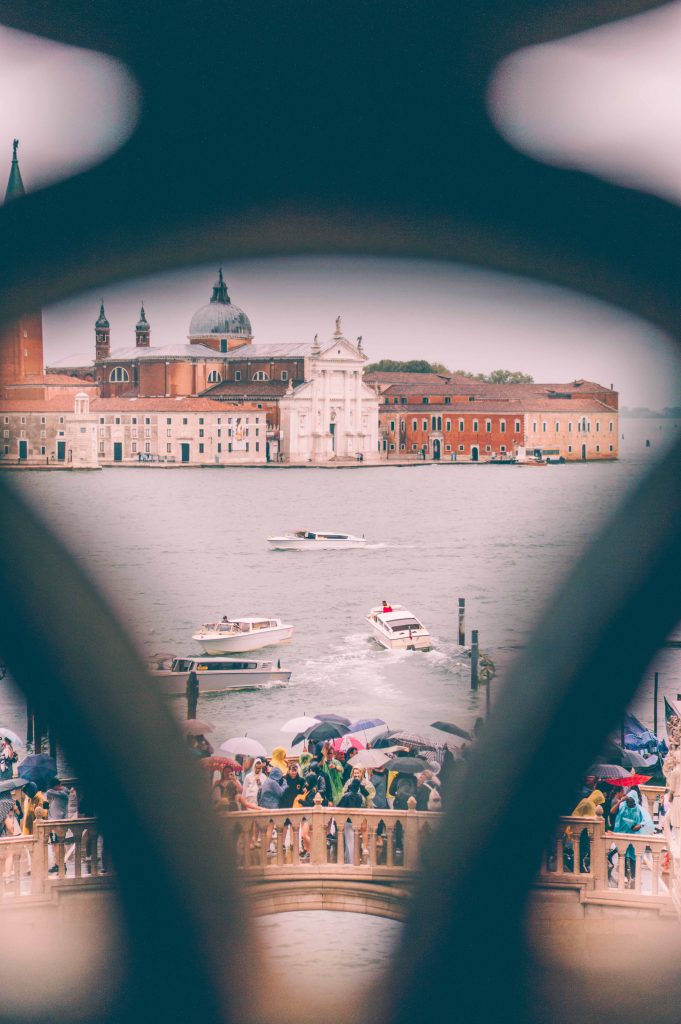
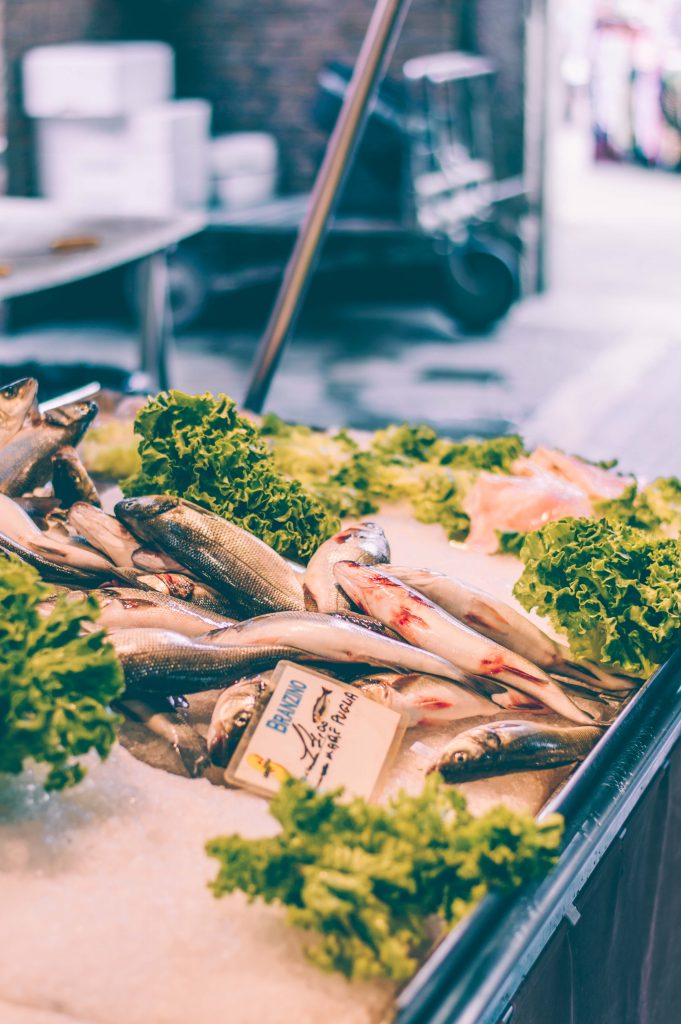
Seafood
Let’s start with the obvious — Venice is surrounded by water. To get fresh seafood, you should make a trip to Rialto Market that has been around for almost a thousand years. Upon entering, you’ll see a sign on the wall written in Venetian dialect of Italian. The sign specifies the size of each category of seafood allowed for sale at the market. Sea bass, for example, has to be at least 12 cm. The rules were imposed hundreds of years ago, but up to this day they help to preserve sustainable practices and make sure the fish is protected and has a chance to reproduce.
The Venetian lagoon and Adriatic Sea provide a wide range of seafood for the region. From mussels and clams to shrimps and squid, seafood is front and center in Venetian cuisine. Fried sardines are served on cicchetti. Risotto di gò, a popular primo dish, is made with black goby, a resident of the lagoon. Secondi, or mains, feature sea bass, bream, and sole, baked whole in the oven.
In fact, if you look at the map, you might notice that Venice itself resembles a fish. So it only makes sense to order seafood as much as possible while in the city.
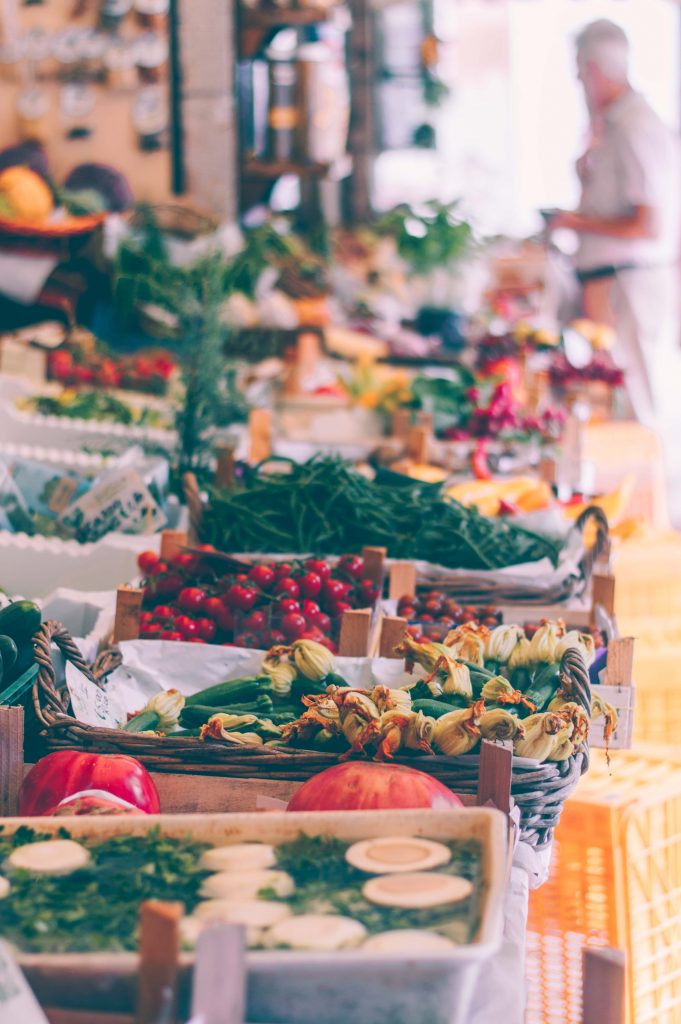
A vegetable stall at Rialto Market in Venice
Vegetables
While visiting Rialto Market, not only will you find fresh catch from the lagoon, but a great variety of fruits and vegetables, too. A lot of it comes from Sant’ Erasmo, the largest island in the Venetian lagoon.
Peas, asparagus, and green salad are common, but the real star is violet artichoke (carciofo violetto). You’ll see it on the menus of many restaurants in Venice during season from late April to the end of June.
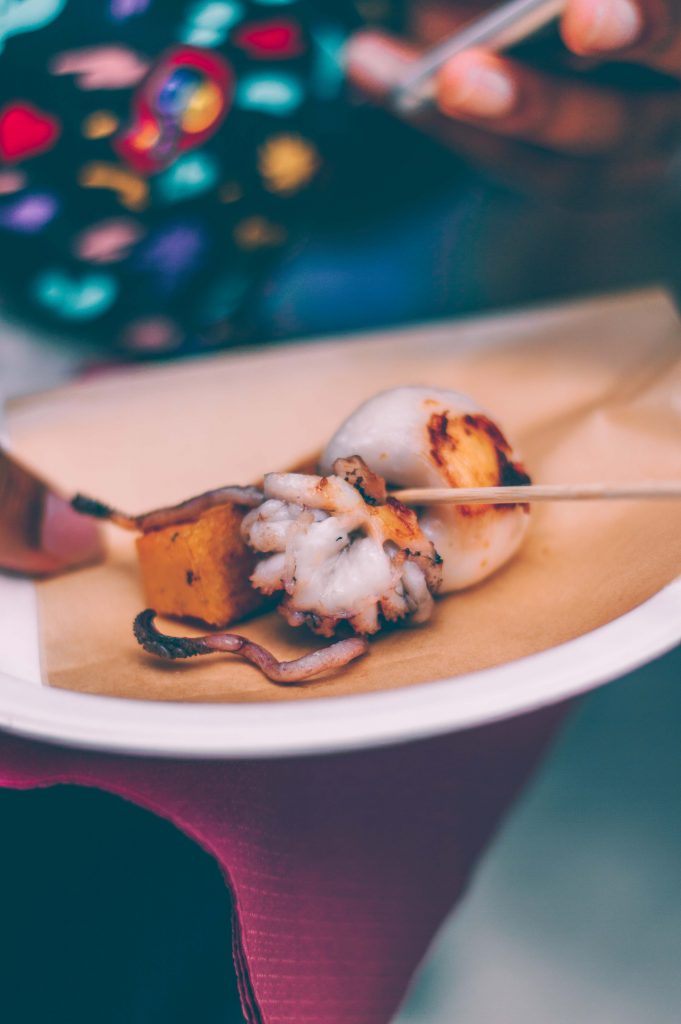
Baby octopus served on top of polenta cake. Two Venetian basics — seafood and polenta — come together in a form of cicchetti.
Polenta and Rice
As the trip to Venice was my introduction to Italy, I was in anticipation of stuffing my face with all the pasta and pizza I could get my hands on. That is until I sat down to learn more about Venetian food. Turned out, pasta is not a staple in the region of Veneto. The most popular carbohydrates are polenta and rice.
Polenta in Venice is cooked in two ways: either as porridge or in a form of a cake (cut into blocks and grilled). Both are served as a side dish with mains, but the cakes can also play the role of base for cicchetti (Venetian tapas).
As for rice, it was among many exotic foods brought from the Arab world to Italy as early as XII century. By XVI century, rice was successfully cultivated in Piedmont, and until this day it is imported to Venice from there, although there are rice growing fields in the region of Veneto too.
Rice is used to prepare risotto and one of the most significant Venetian dishes — risi e bisi — rice with peas.
Spices
With Venetian Republic being the commercial center of Europe, local cuisine was enriched by ingredients from all over the world. One of the most important additions were spices: pepper, saffron, ginger, coriander, cinnamon, and nutmeg to name a few.
These exotic herbs were used for preservation purposes, as well as to enhance the flavor. Which is why today you can try, for example, a seafood risotto prepared with nutmeg, cloves, cinnamon, and ginger.
The spices are also widely used in baking. Around Christmas time, pincia, a local take on bread pudding makes an appearance. Along with stale bread, eggs, and milk, you’ll see cinnamon, fennel seeds, or nutmeg on the ingredient list.
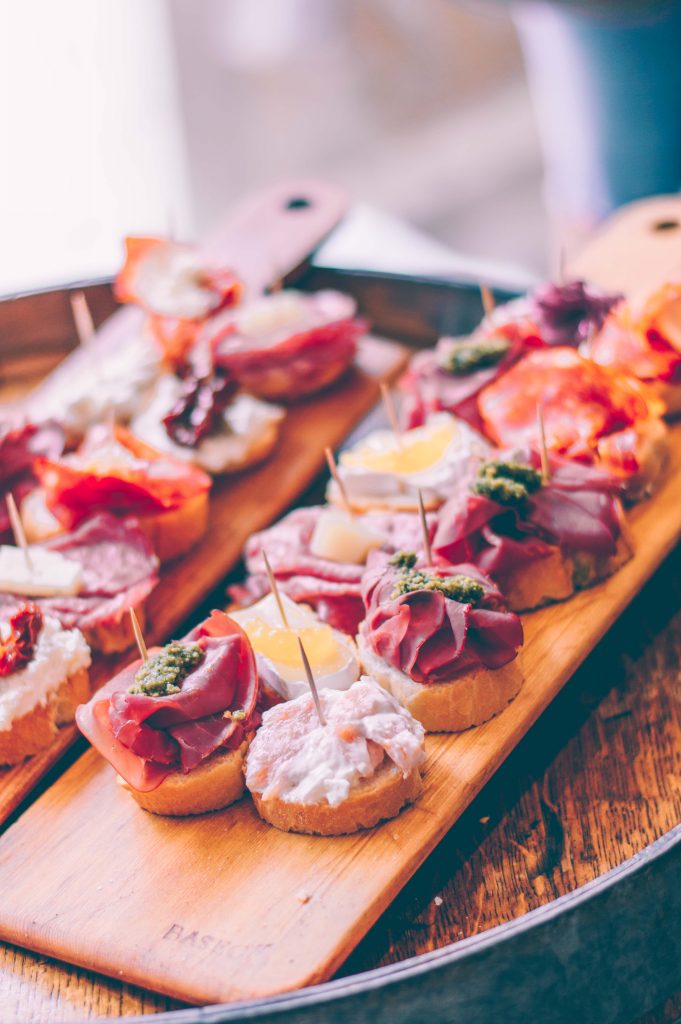
What to Eat in Venice: 15 Traditional Foods You Must Try
Now that we understand the basics of Venetian food, let’s get to the most interesting part — what to eat in Venice! Here are 15 traditional dishes (and drinks) that you should try on your trip.
Some of them, like cicchetti or baccalà mantecato, are extremely easy to find. In fact, you’ll stumble upon them everywhere you go. Others, like pasta e fasioi or risi e bisi will require some research and, possibly, making a detour. Either way, enjoy your time in Venice and eat like locals do!
Appetizers and Snacks

Local cheeses, salami, and olives I’ve tried on a street food tour of Venice.
-
Venetian Cheese and Salami
When we talk about locally produced cheese and salami, they are not made in the city of Venice, but rather in the nearby towns of the region of Veneto.
Two of the most popular brands of salami you should give a try are Nostrano and Sopressa. The latter can be prepared only with meat of animals born and raised in the province of Vicenza of Veneto region. It is made with the finest cuts of pork and throat fat. Apart from salt and pepper, cinnamon, cloves, and garlic can be added to the meat mixture.
When it comes to cheeses, try Montasio that has obtained the mark of Protected Designation of Origin which means it can only be produced in certain parts of Veneto.
But, possibly, the most famous cheese from the region of Veneto is Asiago, named after a small town, located about 100 km away from Venice. It can greatly vary in flavor depending on aging: from semi-soft and mild when fresh to crumbly and intense when aged.
I have tried a variety of local cheeses, salami, and olives on a street food tour of Venice. You can also order a cold cut platter as an appetizer at a restaurant or try it on cicchetti.
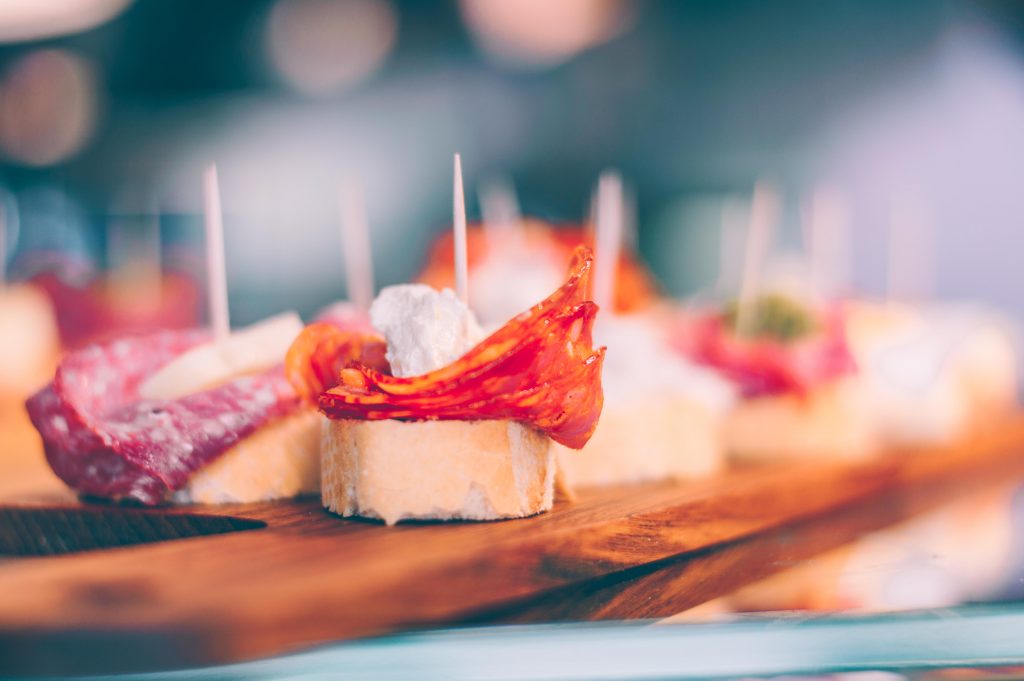
Cicchetti refer to small bites, often served on slices of bread.
-
Cicchetti (Small Bites)
As the guide at our food tour of Venice explained, “cicchetti are like Spanish tapas, but, please, in Venice, never say tapas!” Fair enough! Cicchetti is the name for a category of food — small snacks that are meant to be an affordable and quick way to satisfy hunger. One can have cicchetti for breakfast, lunch, or as a pre-dinner snack enjoyed with a glass of wine.
You’ll see majority of cicchetti served on a slice of bread, with toppings ranging from salami to cheese to creamed fish. Polenta cakes can be used as the base instead of bread slices. But cicchetti can also mean bite-sized food, like chicken wings, a skewer of potato wedges, or meat balls.
A plate of ten to twelve cicchetti can make for a satisfying breakfast or a quick lunch. The price for one is around 2 euro. But remember that it can vary depending on whether you are sitting at the table or eating while standing at the counter.
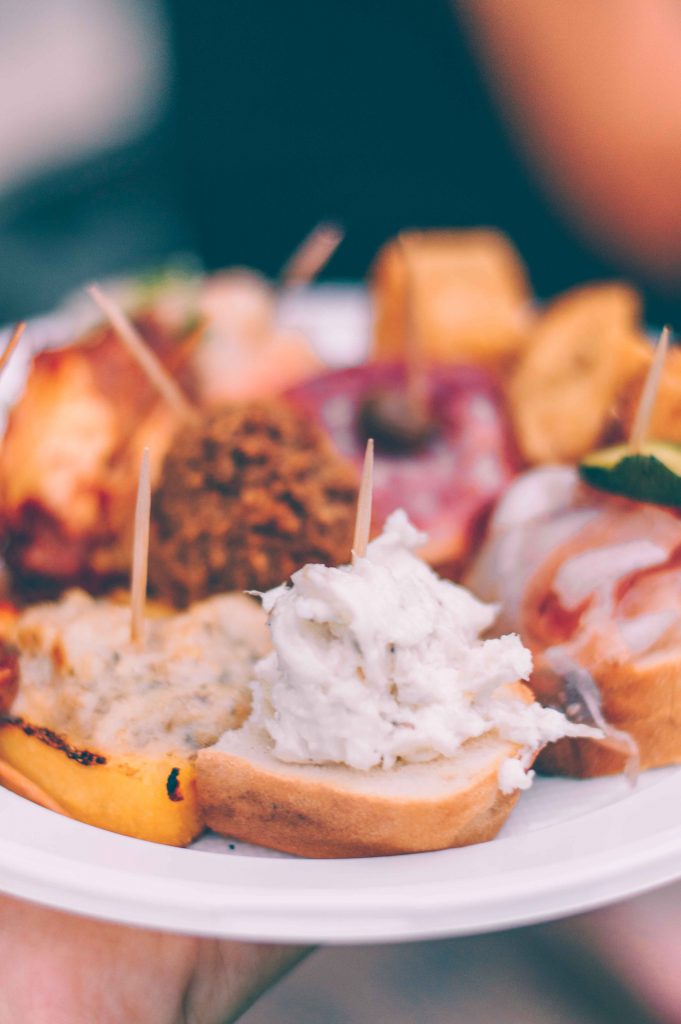
Venetian cicchetto topped with baccalà mantecato
-
Baccalà Mantecato (Dried and Creamed Stockfish)
Remember how we talked about the proximity of the lagoon and Adriatic Sea being major influences on the local cuisine? Well, you’ll be surprised to learn that baccalà mantecato, the most popular Venetian dish, is made with stockfish imported all the way from the shores of Norway!
In his article “Fish of the Venetian lagoons”, Luca Marchiori explains how baccalà, stockfish dried by cold air on wooden racks, made its way to Venice:
“In 1432 a Venetian merchant, Pietro Querini, found himself shipwrecked off the Lofoten islands in Norway. While he was waiting for someone to send a Venetian galley to pick him up, he gorged himself on the local dried fish and bought a large quantity of it as emergency rations for the return journey, in case of similar misfortunes. Arriving back in Venice without incident, Querini sold the baccalà on the Rialto and it became an overnight sensation. Ships have been going back and forth to Norway picking up supplies for hungry Venetians ever since.”
In part, baccalà gained its popularity because of the law by Trento Council that forbade eating meat in 1563 and suggested to replace it with stockfish. To make baccalà mantecato, dried stockfish is dehydrated in water for several days, then poached in milk, and, finally, blended with olive oil, salt, and pepper to preferred texture: it can be chunky or silky smooth. It is usually served on cicchetti or as an appetizer with polenta, but can be a main too.
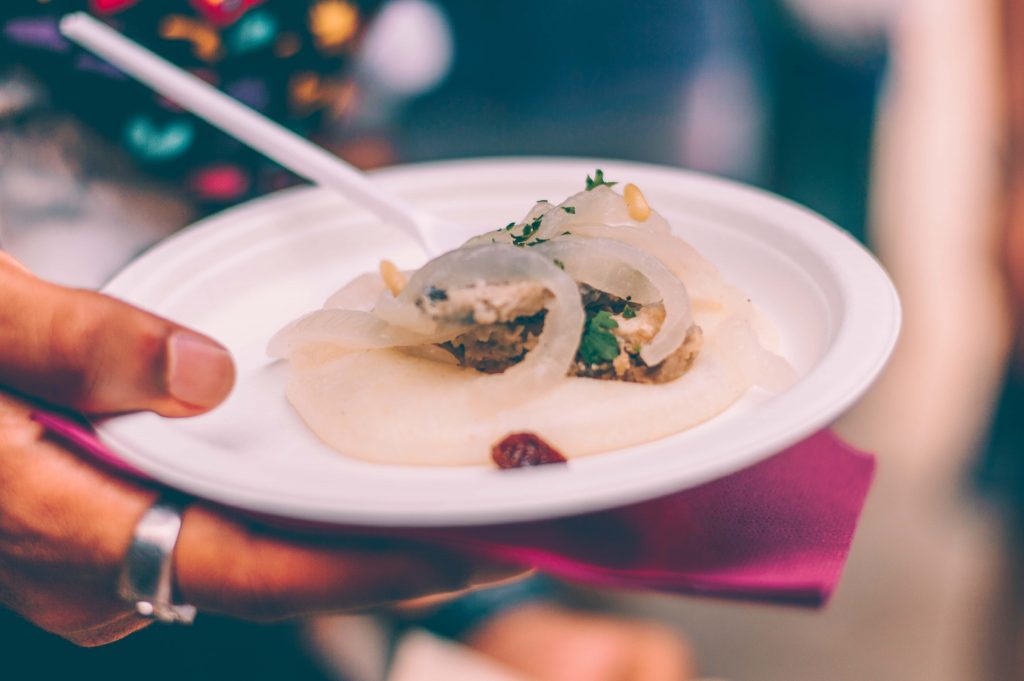
Sarde in saor served on top of white polenta
-
Sarde in Saor (Fried and Marinated Sardines)
Now, sarde in saor is a Venetian dish prepared with sardines caught right in the lagoon. Sardines are dusted with flour and fried; then layered with onions, sultanas, and pine nuts — yet another reminder of the importance of Venice as a trading center back in the day.
Sarde is saor is characterized by its sweet and sour flavor: sweet coming from sultanas and sour — from the use of vinegar. As the recipe is centuries old, it’s not uncommon to see vinegar on the ingredient list for preservation purposes.
Sarde in saor can be served as an appetizer with polenta or on top of cicchetti. I have to admit, it was the one Venetian food I wasn’t fond of. But given that I only tried it at one place, I’ll give sarde in saor another chance next time I am in Venice!
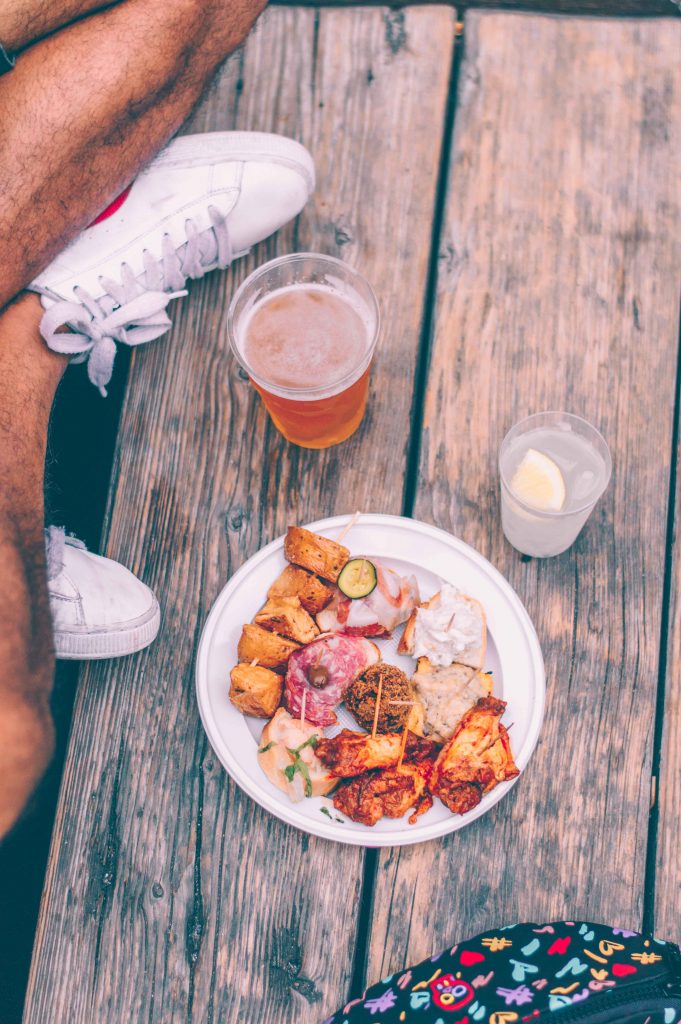
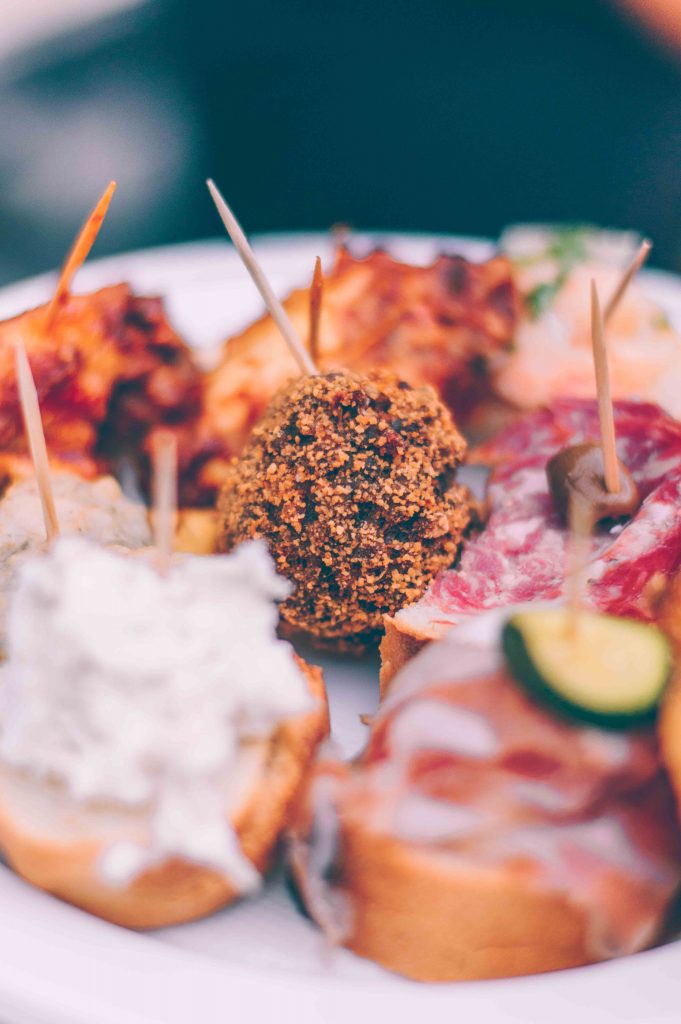
-
Polpetta (Meat Ball)
Polpetta, a deep-fried meat ball, is another popular Venetian cicchetti. As it often happens, the recipe was developed back in the day out of necessity, in this case, to stretch meat supplies and use up leftovers. Ground meat is mixed with herbs and bread, then rolled into balls.
While you’ll find meatballs in many Italian regions served in tomato sauce, in Venice, they are rolled in polenta and deep-fried. Today, you can find polpetta in almost every bacaro (wine bar) or cicchetteria, and they boast a range of flavors: from meat to fish to veggies.

Tramezzini with beef and mustard (on the bottom). I tried my tramezzini with a little twist: served on brown bread and slightly bigger than normal.
-
Tramezzino (Sandwich)
Tramezzino is a triangular sandwich enjoyed best as a snack while walking around Venice, for lunch, or as something to go with your aperetivo in the late afternoon. The sandwich is prepared using white bread with crust cut off, mayonnaise, and a range of fillings like boiled egg and asparagus, tuna salad, beef, or ham.
Tramezzini are usually stuffed to the brim, so the filling seems to fall out any second. Nicoletta of Naturally Epicurean, in her article “Il Tramezzino: the must have Venetian food” explains the origins of the sandwich — most likely British, although several Italian cities fight for the title of tramezzini inventor too — and explains what makes Venetian tramezzini special:
“Well then, why is Venice so famous for something that wasn’t even invented here? The reason is simple: our horrible climate! The dampness that characterizes the lagoon is ideal to maintain tramezzini soft and tender, to be washed down with an ombra or a birrino.”
The tramezzini I tried had a twist on the original version: prepared with brown bread and slightly bigger than normal.
First and Second Courses
-
Polenta e Schie (Polenta with Shrimps)
As I mentioned before, you’ll see polenta served in all different shapes and sizes in Venice: it can be yellow or white; cooked as a porridge or as a cake; served as a side or as a base for cicchetti.
One dish that deserves a special mention is polenta e schie — polenta with shrimps. Schie is a type of tiny gray shrimp found in the Venetian lagoon. It was once food of the poor, but today the price of schie goes as high as 40 euro per kilo.
While you’ll find this dish in many eateries in Venice, the modern take, apparently, is only an approximation of the real deal. Since most of the restaurants are catering to tourists, there’s a chance you’ll get not the lagoon schie, but its cousin that might have been frozen and imported. Erla Zwingle of I Am Not Making This Up explains the origins of polenta e schie and the way it was cooked back in the day in this post.
Polenta and schie is a seasonal dish, served piping hot during winter months. This is one of the Venetian foods I didn’t get to try, but I hope you’ll find a good version if you are visiting Venice in winter.
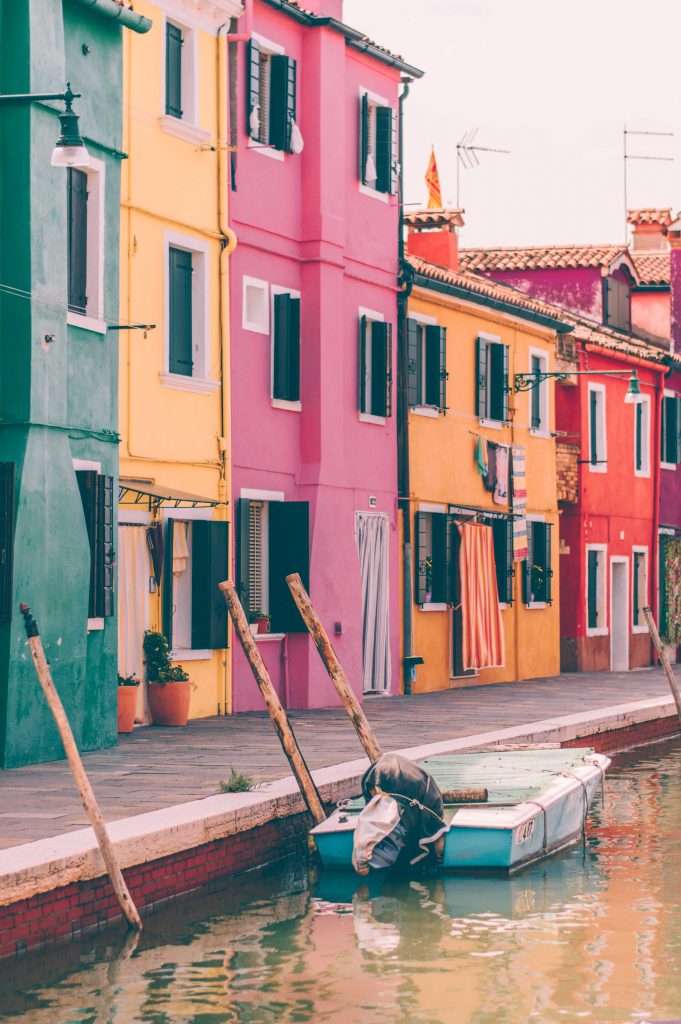
The island of Burano is a famous fishing village where risotto de gò is one of the most popular dishes.
-
Risotto de Gò (Risotto with Goby Fish)
Rice being a staple in Veneto region, risotto should be on the top of your list of what to eat in Venice. Probably the most popular local variety is risotto de gò. Gò, or ghiozzo, is a small, long-bodied fish found in the lagoon. Risotto de gò is traditionally prepared with Vialone Nano rice until dense and creamy.
The easiest way to find it is by taking a vaporetto to the nearby island of Burano, where fishing has been a way of life for centuries.
-
Risi e Bisi (Rice with Peas)
Since we are on the topic of rice, here’s another specialty you should try — risi e bisi — a simple dish that is somewhere in between a soup and a risotto.
The star of the dish, fresh spring peas, make risi e bisi highly seasonal. Unless you order it in spring months, you are likely to get the frozen kind. Purists say that the real risi e bisi should be cooked with peas from Chioggia, a seaside town south of Venice.
Traditionally, the dish was prepared on the 25th of April for the Feast of St. Mark, the patron saint of the city, to celebrate the arrival of the new season’s peas in Rialto market. Even the Doge (the ruler of Venice) would start the celebratory meal with risi e bisi.
Today, unfortunately, it’s not a dish easily found on the menu of restaurants.
-
Bigoli in Salsa (Pasta in Anchovies Sauce)
If you are getting tired of polenta and rice, I have good news for you: there’s one pasta dish typical for Venice — bigoli in salsa. Bigoli is a long thick type of pasta, kinda like spaghetti on steroids.
Luca Marchiori of Luca’s Italy in his article about bigoli in salsa explains,
“Bigoli are a kind of pasta made with semolina flour (semola di grano tenero), salt, and water. They are like thick spaghetti, and similar to Tuscan pici or bringoli… In fact, in many Venetian restaurants today, spaghetti are served as bigoli. Most letter ls are not pronounced in Venetian and so you will often see the word written as it’s said: bigoi.”
The sauce for the pasta is made with just a handful of ingredients: anchovies from the Venetian lagoon, onions, and white wine.
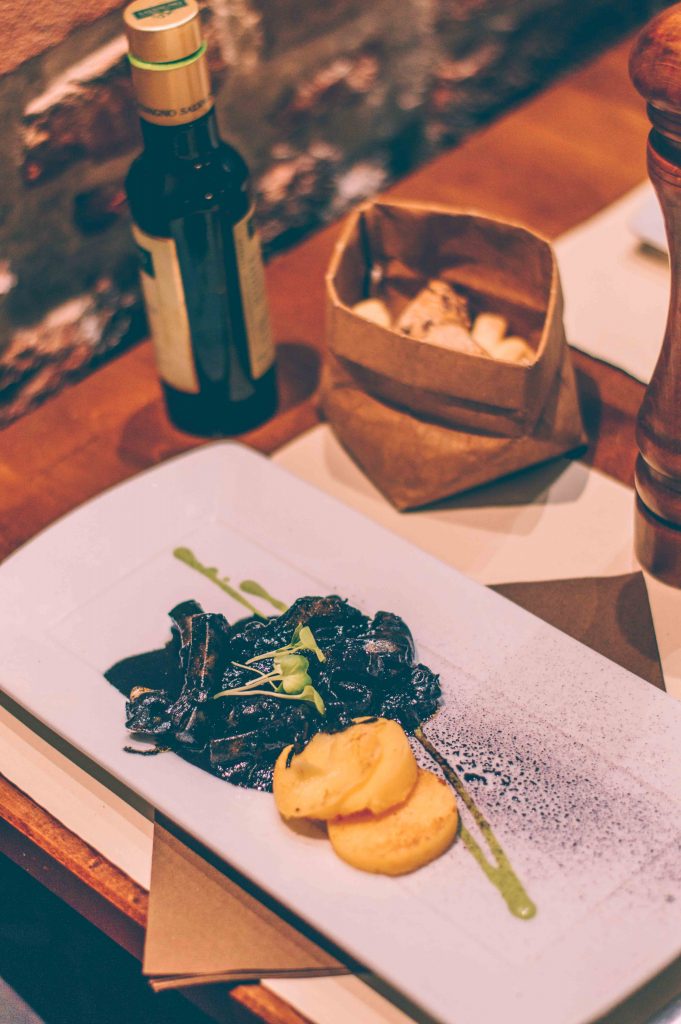
Seppie al nero, squid in its own ink, served with polenta cakes. Told ya polenta is everywhere in Venice!
-
Something al Nero di Seppia (Something in Squid Ink Sauce)
Seppie (squid) is a native of Venetian lagoon and is often found at Rialto Market sold with ink for making strikingly black sauce for pastas and risottos. Different guides on what to eat in Venice recommend to try spaghetti al nero di seppia or risotto al nero di seppia. The latter makes more sense to me since rice is a staple of Venetian cuisine, whereas pasta is less popular in the region of Veneto.
I personally tried seppie al nero (squid in its own ink) served with polenta, and it was a true revelation. I ordered the dish simply because it’s a must-try in Venice, but was skeptical about its taste. The sauce turned out to be delicate, slightly sweet, and like nothing I’ve ever tried before.
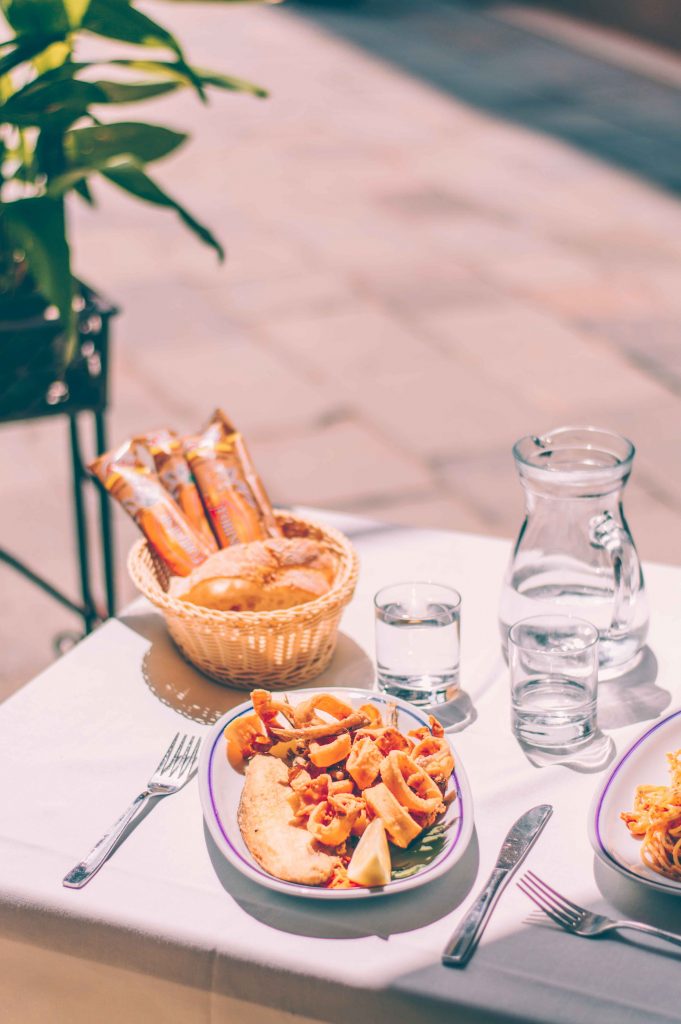
A beautiful plate of fritto misto on a sunny day in Venice.
-
Fritto Misto (Fried Fish and Seafood)
Fritto misto is a popular Italian dish that roughly translates to “mixed fry”. Usually, it includes a wide range of fried foods: from meats to vegetables to even desserts. In Venice, however, fritto misto usually means one thing — fried fish and seafood.
Seafood being one of the pillars of Venetian cuisine, it is no wonder fritto misto is one of those dishes you’ll find everywhere you go. Fish, cuttlefish, sardines, squid tentacles, and shrimps are most commonly used in Venetian fritto misto. It usually comes without sauces, with only a wedge of lemon to squeeze on top.
The dish can be served as a main in restaurants or as a snack that you can munch on while exploring the city. The latter usually comes in a scartosso, a paper cone.
Sweets

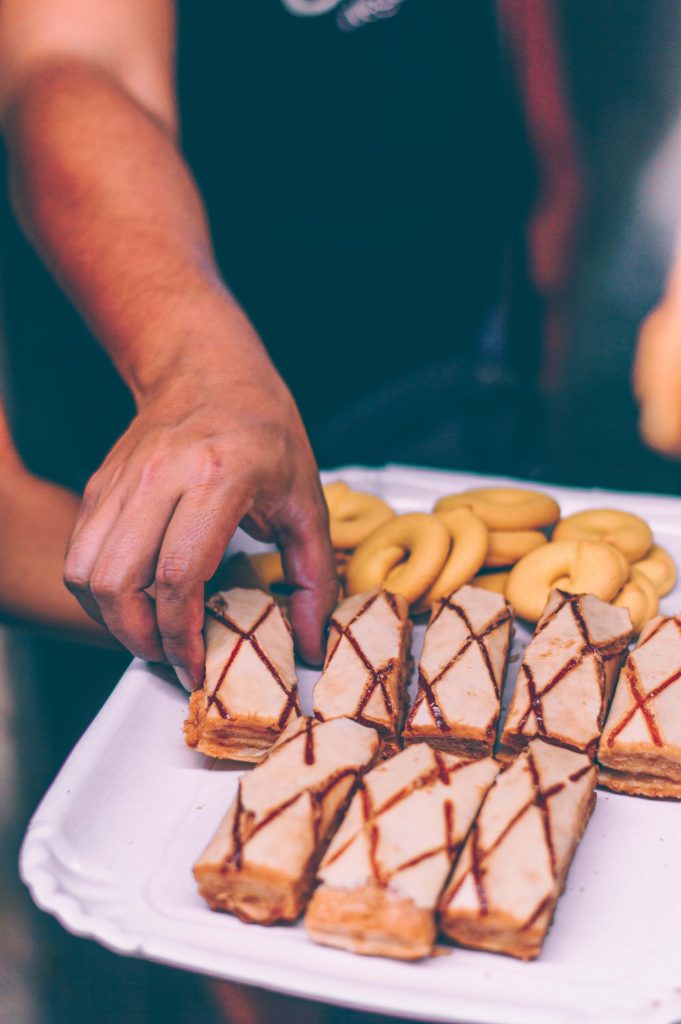
-
Sfogliatine and Buranelli (Venetian Cookies)
Buranelli is a name of two types of cookies that come, as you might have guessed, from Burano island, located a short boat ride away from Venice. In fact, it’s not even two types of cookies, but rather one cookie that comes in two different shapes.
The round one with a hole in the middle is called bussolà, buso being the Venetian word for hole. The other cookie is S-shaped and called essi. Both are bright yellow in color and go well with coffee or dessert wine after dinner. You can easily find buranelli in a local pasticceria (bakery).
Sfogliatine is a light and crunchy cookie made of thin layers of puff pastry and cream. They weigh practically nothing and crumble all over you when you take a bite. They are believed to have originated in Treviso, a province of Veneto region. You can find them packed and ready to go at supermarkets, but I’d rather get mine from a local bakery.
Drinks

Aperol Spritz, the most Italian of Italian cocktails, was invented in the region of Veneto.
-
Aperol Spritz and Select Spritz
And we are off to drinks! Let’s start with the most Italian of all cocktails, Aperol spritz, that was invented in the region of Veneto.
The legend says, that spritz came about in the early XIX century, when the region of Veneto was in ownership of Austro-Hungarian Empire. The soldiers, apparently, found the wines of Northern Italy too strong for their tastes and asked the bar keepers to splash them with a bit of water. The German word for “splash” or “spray” is spritzen. Over time, the tastes have changed, and water was replaced by soda, while wine was mixed with a stronger liquor.
Today, Aperol spritz is made with 3 parts of Prosecco, two parts Aperol, and one splash of soda water. Not only the tradition of mixing water, wine, and bitter comes from Veneto, but Aperol itself too. It was invented in Padua, a province of Veneto region.
However, if you want to make your spritz even more local, try to swap Aperol for Select. Select is a bitter produced right in the heart of Venice, in the district of Castello. It’s bright red in color and features rhubarb roots that give the aperitif its bitter edge.
Both cocktails are finished off with a large green olive that you are supposed to eat after the drink is gone.
-
Bellini
Another cocktail associated with the city of Venice is Bellini, invented in the summer of 1948 by Giuseppe Cipriani, the founder of Harry’s Bar. Located right on the Grand Canal, the bar was frequented by the likes of Ernest Hemingway and Humphrey Bogart.
In the article “A History of the Bellini”, Sam Dangremond quotes Arrigo Cipriani, the son of Giuseppe Cipriani:
“In creating what was to become known as the bellini cocktail in 1948, my father was … inspired by a painter… The 15th century Venetian painter Giovanni Bellini was often mentioned at home. I had no idea at the time that the pink glow my father had so admired in one of Bellini’s paintings would be the inspiration for his famous cocktail.”
The “pink glow” Arrigo Cipriani talks about inspired the use of peach puree in the cocktail. From June to September peaches are in season in Venice. It only made sense to combine them with another regional specialty — Prosecco.
Today, you can still sip on Bellini at Harry’s Bar, where it originated, although it will cost you an arm and a leg.
Now that we are done with 15 foods (and drinks) you must try in Venice, here’s one you probably shouldn’t eat…
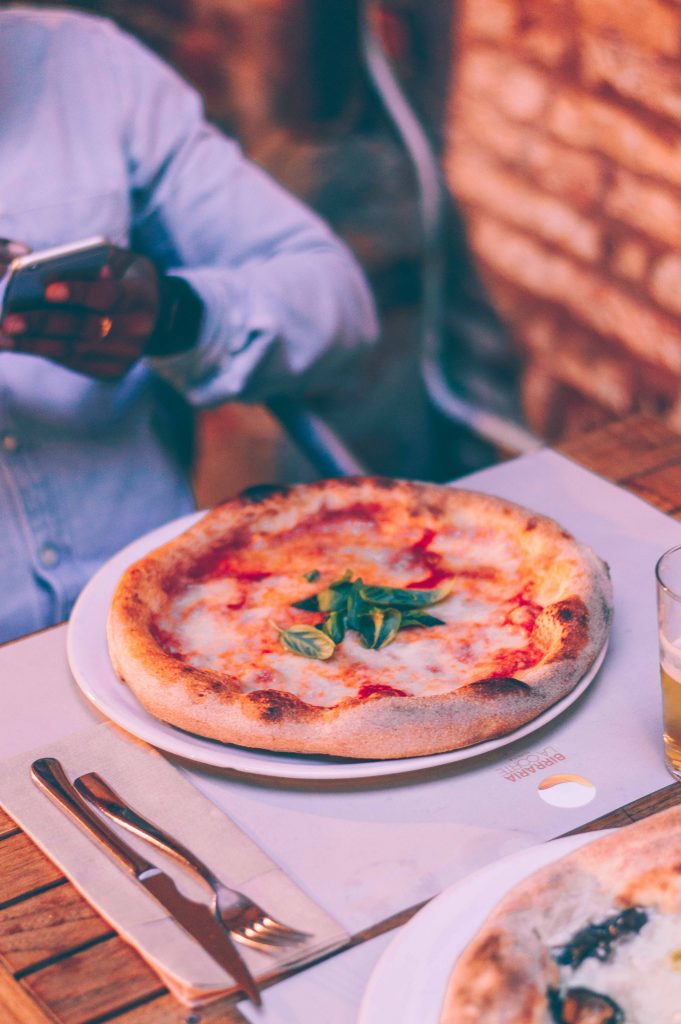
I broke my own rule and had a pizza in Venice!
The One Food You Shouldn’t Eat in Venice — Pizza
This is something every guide on Venice will warn you about — do not order pizza. The reason is quite simple. Traditional Italian pizza must be cooked in a wood-fired oven. In Venice, wood-fired ovens were prohibited due to fire safety concerns.
I have to say, though, that during my 3 days in Venice I had pizza twice. Whaaaaat?! In my defense, it was my first ever trip to Italy, and you don’t seriously expect me to not eat pizza on my first trip to Italy, right?
The key here is to know the right places. I did some research and found two places that are recommended by locals for good pizza. It might not have been on the level of Napoli pizza, but it was honestly good. If you are wondering where to get it, stay tuned for my next post!
A Few More Ideas On What to Eat in Venice
Here are a few more dishes that I didn’t get to try while in Venice, but you absolutely should!
Pasta e fasioi is a soup prepared with pasta and beans and usually served piping hot during colder winter months.
Fegato alla veneziana is a dish that involves calf’s liver, white onions from Chioggia that are famous for their sweet profile, and a splash of vinegar or white wine to balance the sweet taste.
Moeche are deep-fried soft-shell crabs, a highly seasonal dish that you can only try in April and May.
Frittelle are sweet pastries you can find in Venice during Carnival. They are somewhat like doughnuts and can have different fillings (or none at all). The most traditional — frittelle veneziane — is made with raisins and pine nuts mixed right into the dough.
* * *
If you want to cover as many traditional foods in Venice as possible, taking a food tour of Venice guided by a local is a really good idea! I tried this 2.5 hour street food tour, but if you have more time you can book longer tours like this one.
If you are looking for more information about Venice, check out my guide on how to spend 3 days in Venice. Have more ideas on what to eat in Venice? Leave a comment!
Pin for Later:
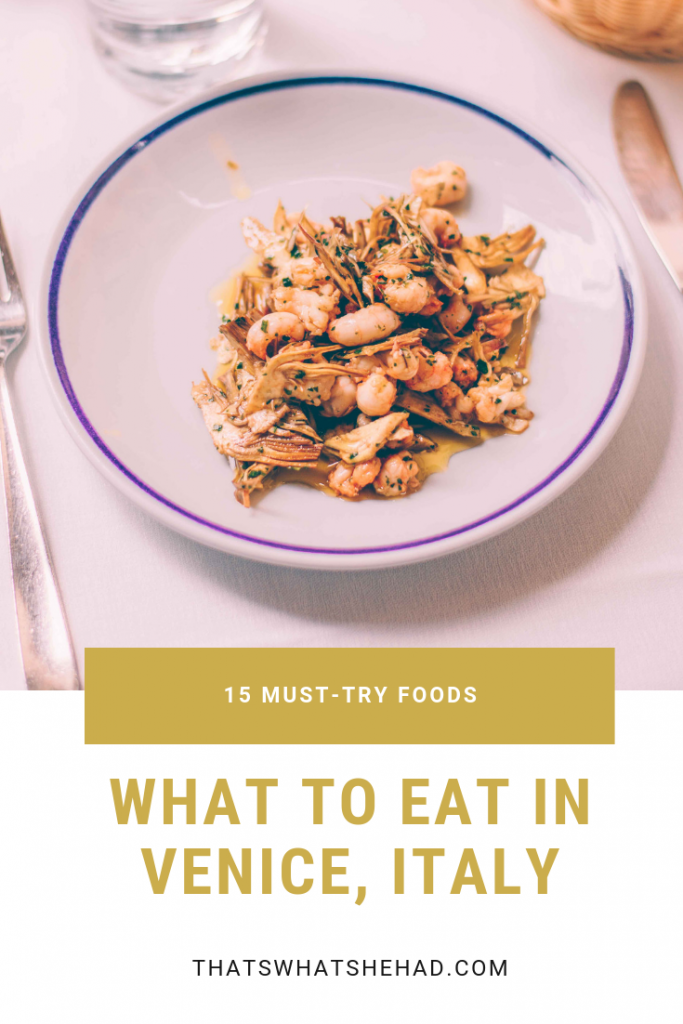
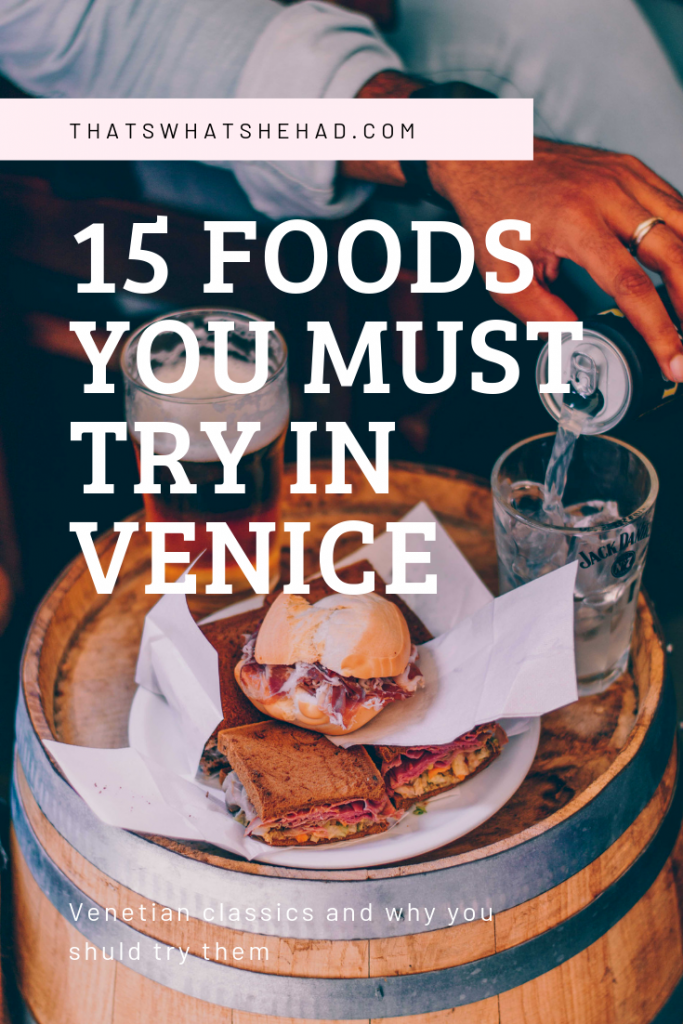
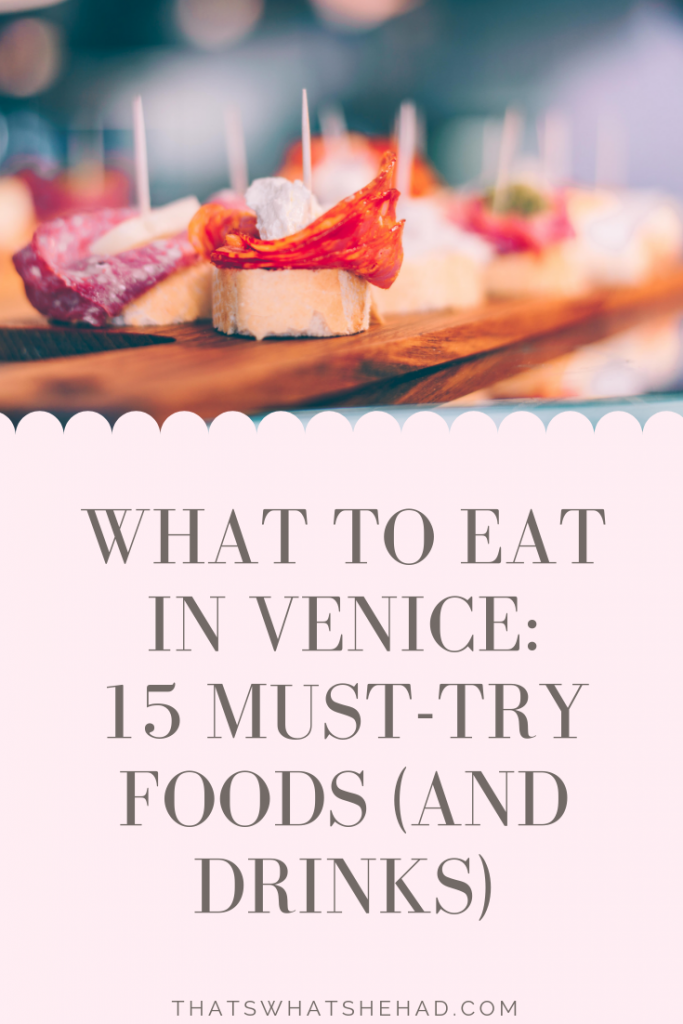




Yulia, it is such a great post! It makes me hungry and now I think I am ready to fly to Venice!
Thank you, Anya! I know many people complain about the food in Venice being mediocre. So happy I could make you feel otherwise! Hope you’ll get to see and taste Venice soon 🙂
I’m heading to Venice in a couple days and found your food writing very helpful! Also heading to Germany after!
Thank you!
Hey Kendall,
happy I could help! Enjoy Venice, it’s a dream!